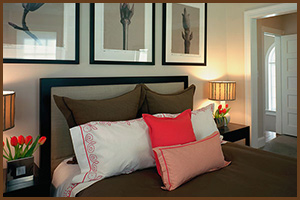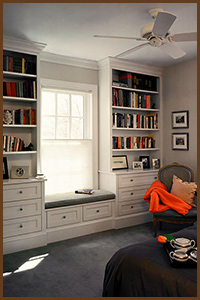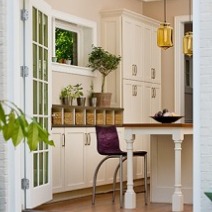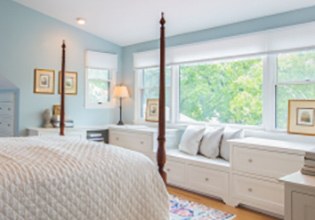How to Make the Most of Your Master Suite
Each year, I meet with approximately 150 homeowners to discuss their home remodeling projects. Among the remodeling projects sought by homeowners in the Washington, DC metropolitan area is a master bedroom and bath remodel, which essentially creates a private domain with a comfortable bedroom, bathroom, and closet. My design experience with master or owner suite remodeling comes from our clients who live in the urban areas of DC and own older homes of modest size. Older homes have less space to work with than the new, larger suburban homes—but in general, the components of a master suite are similar.
At Wentworth, our design/build architects develop designs that reconfigure interior spaces to create master suites where only bedrooms once existed. For our clients who live in smaller homes in the city and do not want to build an addition, we sometimes will combine two bedrooms to create sufficient space for a new master suite. Within this newly designated area, we carve out space for a:
- Bedroom
- Bathroom
- Walk-in closet
Usually 300 – 350 square feet will be sufficient for a modest master suite. These projects involve reconfiguring existing space, building a new master bath or remodeling an old bath, and carving out space for closets, while also considering circulation paths within the new suite.

The Master Bedroom
Master bedrooms do not have to be large. We have designed master suites with bedrooms as small as 11 x 14 feet, although it helps if the owners have a queen-size bed instead of a king-size bed, which requires more room. Space for a bed and two nightstands establishes the bedroom’s minimal width.
Investing in built-in dressers and wardrobes is more efficient, eliminates the need for freestanding furniture, and makes a smaller bedroom practical. Even an 11 x 14 foot bedroom accommodates an easy chair and a wall of built-in dressers and bookcase with a window seat.
In terms of flooring, most of our clients want hardwood flooring in their master bedrooms, although carpeting can be practical for bare feet, is cost-effective, and makes a bedroom quieter.
It is important to consider a variety of lighting, such as lamps for the nightstands or swing-arm lamps for those who read in bed. Recessed lighting or central ceiling mounted light fixtures provide general illumination.
The Master Bathroom
Our urban clients with older homes often opt for a large shower stall instead of a bathtub. If there is a soaking tub elsewhere in the house, often in a hall bath, it is acceptable to not have a tub in the master bathroom. A separate soaking tub (seldom a whirlpool) and separate shower stall can be designed if space is available, which is often not the case with older DC homes. Our suburban clients typically have more space for a separate soaking tub and large shower stall, and freestanding sculptural tubs are currently more popular than deck or platform tubs.
The typical master bath will have two sinks with a vanity cabinet for storage. We recommend at least 66 inches of length for a double-sink vanity—preferably more. Careful design maximizes the storage in a bathroom with recessed wall cabinets, cabinetry that hangs off the wall, and other discrete storage. Marble, limestone, granite, and man-made stones continue to be the preferred countertop material.
Shower stalls are larger and more elaborate now, creating some luxury in the bathroom. The importance of a nice walk-in shower for a master bath cannot be underestimated. A modestly sized shower stall is 36 x 36 square inches. Ideally, the shower would be larger (such as 42 x 60 inches), and for those with ample space, a walk-in shower without a door is an option. Most of our custom shower stalls have a built-in bench and a recessed niche or ledge.
Aging in place is a growing phenomenon and our baby boomer clients ask for grab bars in their shower stalls—the new attractive grab bar designs are not institutional looking. If a client’s budget and the home’s structure allows, we will design curbless shower stalls that eliminate tripping hazards.
Certainly, the refinement of frameless glass shower enclosures has changed the look and function of our shower stalls. Minimalistic frameless glass shower enclosures (usually with 3/8-inch thick tempered glass):
- Provide more useable space
- Create a sense of more room in the entire bathroom
- Bring more light into the shower
- Establish a focal point with wall tile
The Master Closets and Dressing Rooms

A good closet helps organize a master suite and minimizes clutter. Most of the couples we work with share a walk-in master suite closet. Seasonal clothing is often moved to a closet outside the master suite, such as a cedar closet in the attic or basement. Occasionally, couples with sufficient space will each have their own walk-in closet. But as is the case with smaller older homes, options are more limited and the existing space will be reconfigured to maximize space.
Closet design professionals recommend that a walk-in closet be 6 feet wide to allow hanging clothes on both sides with clearance to walk between. When possible, our master suite designs include a 6 x 10 foot walk-in closet, which we feel is an adequate size. Frequently, additional 2-feet-deep traditional-style closets elsewhere in the suite supplement a walk-in closet.
When budget permits, we design built-in dressers and wardrobes to maximize available space and provide aesthetic enhancement. If there’s room, we can design walk-in closets that also act as dressing rooms. A dressing room can be designed with a center island consisting of storage and a stone countertop for laying out the clothes. Dressing rooms are always custom designed, tend to be the size of a large bedroom, and are fitted with:
- Hanging space
- Shelving
- Drawers
- Cubbies
- Good lighting
- All the luxury features available in modern closets
What are you envisioning for your master suite? Call Wentworth—we can turn it into a reality!
About Bruce Wentworth
Wentworth was founded by Bruce Wentworth, AIA, a noted remodeling architect who has worked in the Washington, DC metropolitan area for over twenty years. He has built hundreds of his own designs, ranging from modest bungalows to large-scale luxury residences.







